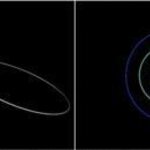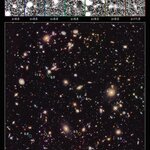Space

17 percent of all sun-like stars have planets one to two times the diameter of Earth orbiting close to their host stars, according to a team of astronomers who created their estimate based on an analysis of the first three years of data from NASA's Kepler mission. Thousands of potential exoplanets have been detected, which is good news for those searching for habitable worlds outside our solar system.
To find planets, the Kepler telescope captures repeated images of 150,000 stars in a region of the sky in the constellation Cygnus. The data are analyzed by computer software in…

I just read with interest and awe the nice article appeared today in the arxiv about the search for dark matter annihilation in the sun's core by the Baksan Underground Scintillator Telescope (BUST), a facility operating since December 1978 (!) in the Caucasian valley of Baksan.
BUST is a detector made of 3150 tanks (approx. 28"x28"x12") of liquid scintillator, arranged in a structure of 17x17x11 meters (see picture below, left). It is located underground at an altitude of 1700 meters. There, the flux of secondary cosmic-ray muons coming from the upper atmosphere is a million times higher…

Planetary systems with very distant binary stars are particularly susceptible to violent disruptions, more so than if they had stellar companions with tighter orbits around them, according to a new paper.
Many stars are members of binary star systems, where two stars orbit one another, and these stars' planetary systems can be altered by the gravity of their companion stars. The orbits of very distant or wide stellar companions often become very eccentric, less circular, over time, driving the once-distant star into a plunging orbit that passes very close to the planets once per orbital…

There are some kinds of turbulence we know exists but proving it is difficult - turbulence in the ionized gas that fills the universe is one such example.
But now a research team says they have directly measured it for the first time - in the laboratory.
One well-known source of gusty space winds are the violent emissions of charged particles from the sun, known as coronal mass ejections. These solar-powered winds can adversely affect satellite communications, air travel and the electric power grid. On the positive side, solar storms also can also lead to mesmerizing auroras at the north and…

Nearby planetary nebula NGC 5189 and its bright gaseous nebula resembles a holiday ornament with a glowing ribbon - so it is perfect for a new Hubble image during the Christmas season.
Planetary nebulae represent the final brief stage in the life of a medium-sized star. While consuming the last of the fuel in its core, the dying star expels a large portion of its outer envelope and this material then becomes heated by the radiation from the stellar remnant and radiates, producing glowing clouds of gas that can show complex structures, as the ejection of mass from the star is uneven in…

The Solar Core is simultaneously Collapsing, and Jetting. The most obvious effect of this phenomena is the Suns Invariance. ie. The Suns size, does not vary significantly. Another way to explain this phenomena, is that the Solar Cores Collapse, to Jetting Ratio is an extremely close match. Eventually, a quantum shift in these ratios will occur, and this will cause the jets to exceed the…

Globular clusters are spherical collections of stars bound to each other by their mutual gravity. They are old, relics of the early years of the Universe, with ages of typically 12-13 billion years, and we know of roughly 150 globular clusters in the Milky Way.
Yet, like many humans, these clusters are still young at heart. Some are aging faster than others and that discovery has led to a way to measure the rate of aging.
Star clusters form in a short period of time, meaning that all the stars within them tend to have roughly the same age. Because bright, high-mass stars burn up…

Tau Ceti, one of the closest stars most like our Sun, may have five planets.
Tau Ceti is just 11.9 light years away and visible to our eyes in the evening sky. It is the closest single star with the same spectral classification as our Sun. Its five planets are estimated to have masses between two and six times the mass of the Earthm making it the lowest-mass planetary system yet detected. One of the planets lies in the habitable zone of the star and has a mass around five times that of Earth, making it the smallest planet found to be orbiting in the habitable zone of a Sun-like star.…

Recently, more than 100 cosmologists, particle physicists and observational astrophysicists at least agreed that dark matter is important. Of course, you are not getting invited to a colloquium on dark matter sponsored by the University of Chicago and the National Academy of Sciences unless you have something positive to say about how close we are to detecting it.
So where do things stand?
"Ten years ago, I don't think you would've found astronomers, cosmologists, and particle physicists all agreeing that dark matter was really important," said Michael S. Turner, Rauner Distinguished…

The Hubble Space Telescope has detected seven primitive galaxies formed more than 13 billion years ago, and also a candidate, at redshift 11.9, for the record for the most distant galaxy found to date.
The images offer the deepest ever view of the Universe at near-infrared wavelengths, which capture the redshifted light of early galaxies. Because light takes so long to travel from these remote objects, astronomers are looking back in time and seeing those galaxies as they appeared just 600 million years after the Big Bang.
Astronomers see the history of the universe in this sense by…